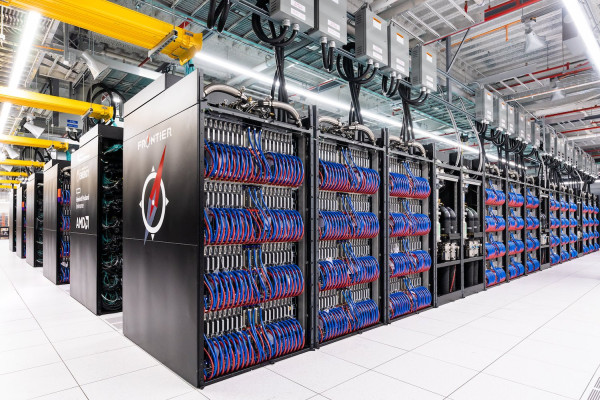The Most Advanced Bay Area Earthquake Simulations Will be Publicly Available
Berkeley Lab’s supercomputer-generated simulations will soon be accessible on an open-access website
February 10, 2023
By

Modeling the effects of earthquakes on homes, businesses, and infrastructure is about to get a lot easier, thanks to advanced simulations performed on the world's fastest supercomputers. (Credit: SUNGYOON/Adobe Stock)
Accurately modeling the effects of an earthquake is possible, but it requires intricate physics-based models that can only be run on advanced supercomputers. The data from such models are invaluable for the earthquake research community and engineers seeking to build and retrofit earthquake-resilient homes, businesses, and infrastructure. However, access to the powerful computers required is extremely limited.
For several years, a team of scientists from Lawrence Berkeley National Laboratory (Berkeley Lab) and Lawrence Livermore National Laboratory has collaborated with the Pacific Earthquake Engineering Research Center (PEER) to fill the access gap by adapting sophisticated, full-scale ground-motion simulations into datasets that can be stored and readily distributed on everyday computers. These datasets are free to the public.
Now, the collaboration is planning to release the most accurate and detailed simulations to date, which initially will capture earthquake motions across the San Francisco Bay Area and later expand to other regions of the state.
Now, the collaboration is planning to release the most accurate and detailed simulations to date, which initially will capture earthquake motions across the San Francisco Bay Area and later expand to other regions of the state.
“With our simulation software, called EQSIM, ground motion simulations of unprecedented fidelity and unprecedented spatial coverage can now be generated,” said project leader David McCallen, a senior scientist in Berkeley Lab’s Earth & Environmental Sciences Area and leader of the Critical Infrastructure Initiative.
To give a sense of how detailed these models are, McCallen notes that there is ground motion data at approximately every two meters of land throughout the Bay Area, which sits on several active faults, including the Hayward and San Andreas faults. “The regional ground motion simulations are so computationally intensive that they require the absolute largest and fastest computers that are available anywhere in the world.”
The EQSIM software was built and tested using the Summit supercomputer at Oak Ridge National Laboratory (ORNL) and the Perlmutter system at Berkeley Lab’s National Energy Research Scientific Computing Center (NERSC). Sharing the massive amounts of data needed to design and operate this software across different platforms was accomplished through the Department of Energy (DOE) Energy Sciences Network (ESnet), created and managed by Berkeley Lab.
McCallen and his collaborators will further enhance their simulations using the newest DOE supercomputer, ORNL’s Frontier, when it becomes available in early 2023. Frontier is the world’s first exascale computer, meaning it can calculate at least a billion billion (1018) operations per second. The team was awarded some highly sought-after computing time on Frontier through the DOE Office of Science Innovative and Novel Computational Impact on Theory and Experiment (INCITE) program.

A glimpse of the Frontier System at ORNL. (Credit: Oak Ridge National Laboratory Leadership Computing Facility)
“The plan is we at Berkeley Lab will perform these extremely intense simulations on DOE’s supercomputers and we will work closely with PEER to appropriately make these simulated motions available to the broad earth science and earthquake engineering communities, as well as organizations responsible for disaster response,” said McCallen.
PEER is a multi-institution earthquake research and education center headquartered at UC Berkeley. Part of the center’s mission is to develop and maintain ground motions datasets made from actual recordings of earthquakes occurring around the world. These valuable resources are used by thousands of research teams, but as PEER director and civil engineering professor Khalid Mosalam points out, there is simply not enough real-world data to fill the gaps in our understanding nor to adequately prepare for future earthquakes.
“Particularly, data is very limited for large magnitude events. In an expected big earthquake near the San Francisco Bay Area or Los Angeles, critical infrastructure, tall buildings, and important bridges will be subjected to high magnitude ground motions, so developing such motions from simulations is essential for community safety and resilience,” said Mosalam. “The upcoming simulation-based dataset will be instrumental for facilitating deeper understanding of the hazard, performance, and overall resiliency of California, allowing officials to identify the infrastructure systems and structures that pose the largest risk in an effective and accurate manner, and properly allocate resources.”
EQSIM is funded and supported by the Exascale Computing Project, a seven-year, DOE multi-lab project to develop a capable exascale computing ecosystem necessary for the implementation of the nation’s first exascale supercomputers. NERSC is a DOE Office of Science user facility.
About Computing Sciences at Berkeley Lab
High performance computing plays a critical role in scientific discovery. Researchers increasingly rely on advances in computer science, mathematics, computational science, data science, and large-scale computing and networking to increase our understanding of ourselves, our planet, and our universe. Berkeley Lab’s Computing Sciences Area researches, develops, and deploys new foundations, tools, and technologies to meet these needs and to advance research across a broad range of scientific disciplines.







 Instagram
Instagram YouTube
YouTube